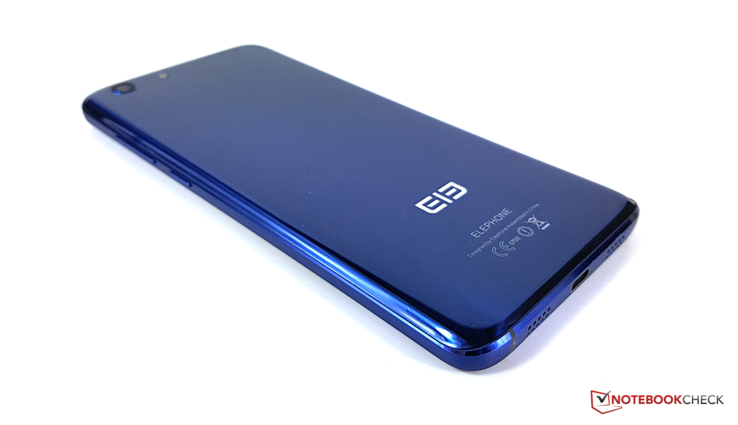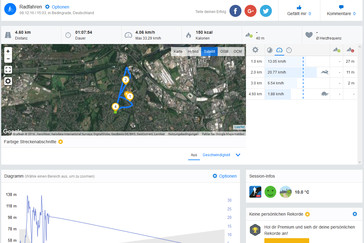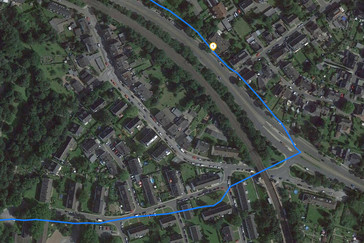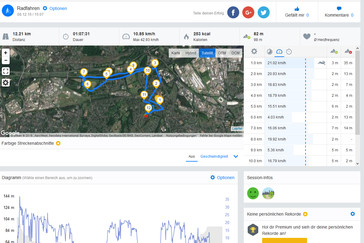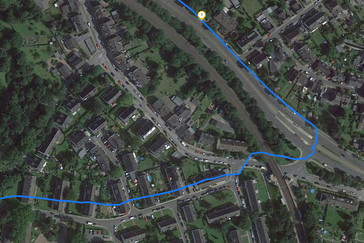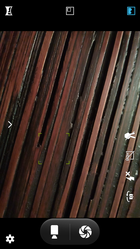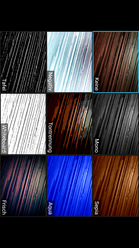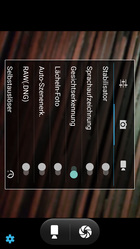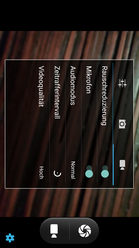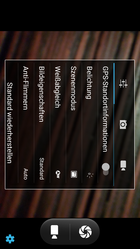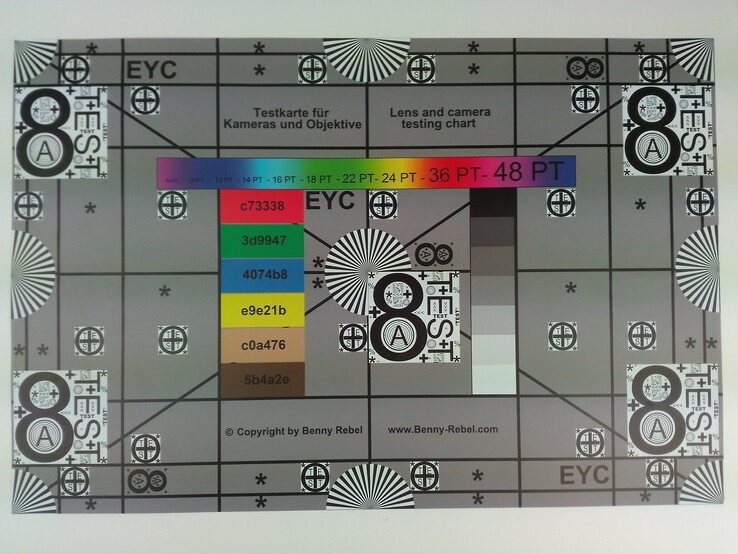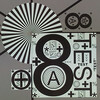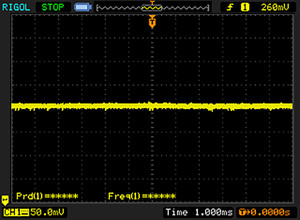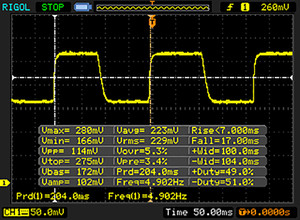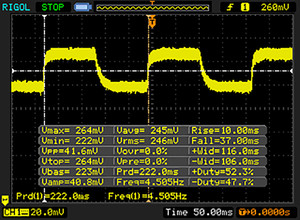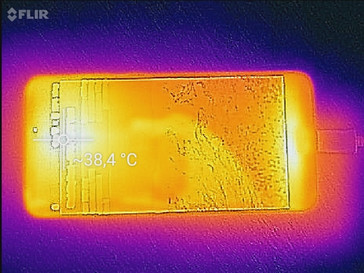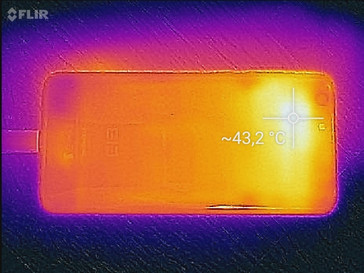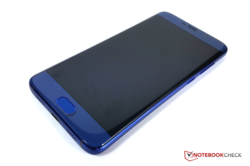ElePhone S7 智能手机简短评测
» Notebookcheck多媒体笔记本电脑Top 10排名
» Notebookcheck游戏笔记本电脑Top 10排名
» Notebookcheck低价办公/商务笔记本电脑Top 10排名
» Notebookcheck高端办公/商务笔记本电脑Top 10排名
» Notebookcheck工作站笔记本电脑Top 10排名
» Notebookcheck亚笔记本电脑Top 10排名
» Notebookcheck超级本产品Top 10排名
» Notebookcheck变形本产品Top 10排名
» Notebookcheck平板电脑Top 10排名
» Notebookcheck智能手机Top 10排名
» Notebookcheck评测过最出色的笔记本电脑屏幕
» Notebookcheck售价500欧元以下笔记本电脑Top 10排名
» Notebookcheck售价300欧元以下笔记本电脑Top 10排名
| Networking | |
| iperf3 transmit AX12 | |
| Samsung Galaxy S7 Edge | |
| Elephone S7 | |
| iperf3 receive AX12 | |
| Samsung Galaxy S7 Edge | |
| Elephone S7 | |
| iperf Server (receive) TCP 1 m | |
| Samsung Galaxy S7 Edge | |
| UMI Super Euro Edition | |
| Blackview R7 | |
| Vernee Mars | |
| Honor 5C | |
| iperf Client (transmit) TCP 1 m | |
| Samsung Galaxy S7 Edge | |
| UMI Super Euro Edition | |
| Blackview R7 | |
| Honor 5C | |
| Vernee Mars | |
| |||||||||||||||||||||||||
Brightness Distribution: 95 %
Center on Battery: 391 cd/m²
Contrast: 954:1 (Black: 0.41 cd/m²)
ΔE ColorChecker Calman: 8.2 | ∀{0.5-29.43 Ø4.78}
ΔE Greyscale Calman: 9.8 | ∀{0.09-98 Ø5}
Gamma: 2.27
CCT: 10108 K
| Elephone S7 IPS, 1920x1080, 5.5" | ZTE Blade V7 IPS, 1920x1080, 5.2" | Honor 5C IPS, 1920x1080, 5.2" | UMI Super Euro Edition IPS, 1920x1080, 5.5" | Vernee Mars IPS, 1920x1080, 5.5" | Blackview R7 IPS, 1920x1080, 5.5" | Samsung Galaxy S7 Edge Super AMOLED, 2560x1440, 5.5" | |
|---|---|---|---|---|---|---|---|
| Screen | -2% | 15% | 29% | 30% | -14% | 55% | |
| Brightness middle (cd/m²) | 391 | 409 5% | 515 32% | 418 7% | 345 -12% | 552 41% | 554 42% |
| Brightness (cd/m²) | 379 | 411 8% | 498 31% | 410 8% | 339 -11% | 526 39% | 552 46% |
| Brightness Distribution (%) | 95 | 96 1% | 93 -2% | 85 -11% | 85 -11% | 91 -4% | 96 1% |
| Black Level * (cd/m²) | 0.41 | 0.38 7% | 0.49 -20% | 0.31 24% | 0.14 66% | 0.64 -56% | |
| Contrast (:1) | 954 | 1076 13% | 1051 10% | 1348 41% | 2464 158% | 863 -10% | |
| Colorchecker dE 2000 * | 8.2 | 9.4 -15% | 6.2 24% | 4.4 46% | 7.1 13% | 11 -34% | 1.59 81% |
| Colorchecker dE 2000 max. * | 14.7 | 17.6 -20% | 11.4 22% | 6.5 56% | 13.9 5% | 20.8 -41% | 2.56 83% |
| Greyscale dE 2000 * | 9.8 | 11.6 -18% | 7.4 24% | 3.6 63% | 6.7 32% | 14.3 -46% | 2.01 79% |
| Gamma | 2.27 97% | 2.25 98% | 2.28 96% | 2.36 93% | 2.47 89% | 2.21 100% | 2.01 109% |
| CCT | 10108 64% | 9597 68% | 8664 75% | 6993 93% | 7711 84% | 12996 50% | 6321 103% |
| Color Space (Percent of AdobeRGB 1998) (%) | 82.12 | ||||||
| Color Space (Percent of sRGB) (%) | 99.98 |
* ... smaller is better
Screen Flickering / PWM (Pulse-Width Modulation)
| Screen flickering / PWM not detected | |||
In comparison: 53 % of all tested devices do not use PWM to dim the display. If PWM was detected, an average of 8111 (minimum: 5 - maximum: 343500) Hz was measured. | |||
Display Response Times
| ↔ Response Time Black to White | ||
|---|---|---|
| 23 ms ... rise ↗ and fall ↘ combined | ↗ 7 ms rise | |
| ↘ 17 ms fall | ||
| The screen shows good response rates in our tests, but may be too slow for competitive gamers. In comparison, all tested devices range from 0.1 (minimum) to 240 (maximum) ms. » 50 % of all devices are better. This means that the measured response time is worse than the average of all tested devices (20.2 ms). | ||
| ↔ Response Time 50% Grey to 80% Grey | ||
| 47 ms ... rise ↗ and fall ↘ combined | ↗ 10 ms rise | |
| ↘ 37 ms fall | ||
| The screen shows slow response rates in our tests and will be unsatisfactory for gamers. In comparison, all tested devices range from 0.165 (minimum) to 636 (maximum) ms. » 80 % of all devices are better. This means that the measured response time is worse than the average of all tested devices (31.6 ms). | ||
| AnTuTu v6 - Total Score (sort by value) | |
| Elephone S7 | |
| ZTE Blade V7 | |
| Honor 5C | |
| UMI Super Euro Edition | |
| Vernee Mars | |
| Blackview R7 | |
| Samsung Galaxy S7 Edge | |
| Huawei P9 Plus | |
| Geekbench 4.0 | |
| 64 Bit Single-Core Score (sort by value) | |
| Elephone S7 | |
| UMI Super Euro Edition | |
| Vernee Mars | |
| Blackview R7 | |
| Samsung Galaxy S7 Edge | |
| 64 Bit Multi-Core Score (sort by value) | |
| Elephone S7 | |
| UMI Super Euro Edition | |
| Vernee Mars | |
| Blackview R7 | |
| Samsung Galaxy S7 Edge | |
| GFXBench (DX / GLBenchmark) 2.7 | |
| T-Rex Onscreen (sort by value) | |
| Elephone S7 | |
| ZTE Blade V7 | |
| Honor 5C | |
| UMI Super Euro Edition | |
| Vernee Mars | |
| Blackview R7 | |
| Samsung Galaxy S7 Edge | |
| Huawei P9 Plus | |
| 1920x1080 T-Rex Offscreen (sort by value) | |
| Elephone S7 | |
| ZTE Blade V7 | |
| Honor 5C | |
| UMI Super Euro Edition | |
| Vernee Mars | |
| Blackview R7 | |
| Samsung Galaxy S7 Edge | |
| Huawei P9 Plus | |
| GFXBench 3.0 | |
| on screen Manhattan Onscreen OGL (sort by value) | |
| Elephone S7 | |
| ZTE Blade V7 | |
| Honor 5C | |
| UMI Super Euro Edition | |
| Vernee Mars | |
| Blackview R7 | |
| Samsung Galaxy S7 Edge | |
| Huawei P9 Plus | |
| 1920x1080 1080p Manhattan Offscreen (sort by value) | |
| Elephone S7 | |
| ZTE Blade V7 | |
| Honor 5C | |
| UMI Super Euro Edition | |
| Vernee Mars | |
| Blackview R7 | |
| Samsung Galaxy S7 Edge | |
| Huawei P9 Plus | |
| GFXBench 3.1 | |
| on screen Manhattan ES 3.1 Onscreen (sort by value) | |
| Elephone S7 | |
| ZTE Blade V7 | |
| Honor 5C | |
| UMI Super Euro Edition | |
| Vernee Mars | |
| Blackview R7 | |
| Samsung Galaxy S7 Edge | |
| Huawei P9 Plus | |
| 1920x1080 Manhattan ES 3.1 Offscreen (sort by value) | |
| Elephone S7 | |
| ZTE Blade V7 | |
| Honor 5C | |
| UMI Super Euro Edition | |
| Vernee Mars | |
| Blackview R7 | |
| Samsung Galaxy S7 Edge | |
| Huawei P9 Plus | |
| PCMark for Android - Work performance score (sort by value) | |
| Elephone S7 | |
| ZTE Blade V7 | |
| Honor 5C | |
| UMI Super Euro Edition | |
| Vernee Mars | |
| Blackview R7 | |
| Samsung Galaxy S7 Edge | |
| Huawei P9 Plus | |
| Mozilla Kraken 1.1 - Total | |
| ZTE Blade V7 | |
| Blackview R7 | |
| UMI Super Euro Edition | |
| Vernee Mars | |
| Honor 5C | |
| Elephone S7 | |
| Samsung Galaxy S7 Edge | |
| Octane V2 - Total Score | |
| Samsung Galaxy S7 Edge | |
| Honor 5C | |
| UMI Super Euro Edition | |
| Vernee Mars | |
| Blackview R7 | |
| Elephone S7 | |
| ZTE Blade V7 | |
| JetStream 1.1 - Total Score | |
| Samsung Galaxy S7 Edge | |
| Elephone S7 | |
| Honor 5C | |
| Vernee Mars | |
| UMI Super Euro Edition | |
| Blackview R7 | |
| ZTE Blade V7 | |
* ... smaller is better
| Elephone S7 Mali-T880 MP4, Helio X20 MT6797, 64 GB eMMC Flash | ZTE Blade V7 Mali-T720 MP4, MT6753, 16 GB eMMC Flash | Honor 5C Mali-T830 MP2, Kirin 650, 16 GB eMMC Flash | UMI Super Euro Edition Mali-T860 MP2, Helio P10 MT6755, 32 GB eMMC Flash | Vernee Mars Mali-T860 MP2, Helio P10 MT6755, 32 GB eMMC Flash | Blackview R7 Mali-T860 MP2, Helio P10 MT6755, 32 GB eMMC Flash | Samsung Galaxy S7 Edge Mali-T880 MP12, Exynos 8890, 32 GB UFS 2.0 Flash | |
|---|---|---|---|---|---|---|---|
| AndroBench 3-5 | -2% | 56% | 14% | 21% | -5% | 136% | |
| Sequential Write 256KB SDCard (MB/s) | 18.57 | 20.89 12% | 24.21 30% | 17.88 -4% | 24 29% | 11.87 -36% | 50.4 171% |
| Sequential Read 256KB SDCard (MB/s) | 32.86 | 43.67 33% | 51.9 58% | 36.22 10% | 44.5 35% | 15.56 -53% | 76.4 133% |
| Random Write 4KB (MB/s) | 7.89 | 7.58 -4% | 15.7 99% | 11.88 51% | 15.77 100% | 11.4 44% | 15.79 100% |
| Random Read 4KB (MB/s) | 21.8 | 28.07 29% | 61.7 183% | 28.17 29% | 21.66 -1% | 28.02 29% | 86.7 298% |
| Sequential Write 256KB (MB/s) | 167.1 | 39.45 -76% | 75.5 -55% | 126.9 -24% | 71.6 -57% | 122.7 -27% | 145.1 -13% |
| Sequential Read 256KB (MB/s) | 213.8 | 196.8 -8% | 263 23% | 257.8 21% | 255.9 20% | 247.6 16% | 487.3 128% |
| Dead Trigger 2 | |||
| Settings | Value | ||
| high | 34 fps | ||
| Asphalt 8: Airborne | |||
| Settings | Value | ||
| high | 27 fps | ||
| very low | 30 fps | ||
(+) The maximum temperature on the upper side is 37.5 °C / 100 F, compared to the average of 35.2 °C / 95 F, ranging from 21.9 to 247 °C for the class Smartphone.
(±) The bottom heats up to a maximum of 42.4 °C / 108 F, compared to the average of 34 °C / 93 F
(+) In idle usage, the average temperature for the upper side is 30.5 °C / 87 F, compared to the device average of 32.9 °C / 91 F.
Elephone S7 audio analysis
(+) | speakers can play relatively loud (90.5 dB)
Bass 100 - 315 Hz
(-) | nearly no bass - on average 43.9% lower than median
(+) | bass is linear (6.4% delta to prev. frequency)
Mids 400 - 2000 Hz
(±) | reduced mids - on average 9.8% lower than median
(±) | linearity of mids is average (8.7% delta to prev. frequency)
Highs 2 - 16 kHz
(+) | balanced highs - only 4.5% away from median
(+) | highs are linear (5.1% delta to prev. frequency)
Overall 100 - 16.000 Hz
(±) | linearity of overall sound is average (29.1% difference to median)
Compared to same class
» 76% of all tested devices in this class were better, 3% similar, 21% worse
» The best had a delta of 11%, average was 35%, worst was 134%
Compared to all devices tested
» 87% of all tested devices were better, 2% similar, 11% worse
» The best had a delta of 4%, average was 24%, worst was 134%
Samsung Galaxy S7 Edge audio analysis
(+) | speakers can play relatively loud (88.7 dB)
Bass 100 - 315 Hz
(-) | nearly no bass - on average 27.4% lower than median
(±) | linearity of bass is average (8.7% delta to prev. frequency)
Mids 400 - 2000 Hz
(+) | balanced mids - only 4.4% away from median
(+) | mids are linear (4.7% delta to prev. frequency)
Highs 2 - 16 kHz
(±) | higher highs - on average 5.8% higher than median
(+) | highs are linear (6.2% delta to prev. frequency)
Overall 100 - 16.000 Hz
(±) | linearity of overall sound is average (20.6% difference to median)
Compared to same class
» 35% of all tested devices in this class were better, 9% similar, 56% worse
» The best had a delta of 11%, average was 35%, worst was 134%
Compared to all devices tested
» 54% of all tested devices were better, 8% similar, 38% worse
» The best had a delta of 4%, average was 24%, worst was 134%
Honor 5C audio analysis
(+) | speakers can play relatively loud (87.9 dB)
Bass 100 - 315 Hz
(-) | nearly no bass - on average 30.9% lower than median
(±) | linearity of bass is average (8.1% delta to prev. frequency)
Mids 400 - 2000 Hz
(±) | higher mids - on average 7.1% higher than median
(±) | linearity of mids is average (8.8% delta to prev. frequency)
Highs 2 - 16 kHz
(±) | higher highs - on average 12.1% higher than median
(+) | highs are linear (2.9% delta to prev. frequency)
Overall 100 - 16.000 Hz
(-) | overall sound is not linear (31.7% difference to median)
Compared to same class
» 81% of all tested devices in this class were better, 2% similar, 16% worse
» The best had a delta of 11%, average was 35%, worst was 134%
Compared to all devices tested
» 90% of all tested devices were better, 2% similar, 8% worse
» The best had a delta of 4%, average was 24%, worst was 134%
| Off / Standby | |
| Idle | |
| Load |
|
Key:
min: | |
| Elephone S7 3000 mAh | ZTE Blade V7 2540 mAh | Honor 5C 3000 mAh | UMI Super Euro Edition 4000 mAh | Vernee Mars 3000 mAh | Blackview R7 3000 mAh | Samsung Galaxy S7 Edge 3600 mAh | |
|---|---|---|---|---|---|---|---|
| Power Consumption | 45% | 24% | 14% | 23% | -29% | 33% | |
| Idle Minimum * (Watt) | 1.42 | 0.73 49% | 0.89 37% | 0.84 41% | 1.02 28% | 1.83 -29% | 0.63 56% |
| Idle Average * (Watt) | 1.87 | 0.92 51% | 2.07 -11% | 1.94 -4% | 1.69 10% | 3.21 -72% | 1.1 41% |
| Idle Maximum * (Watt) | 2.11 | 0.93 56% | 2.15 -2% | 2.07 2% | 1.82 14% | 3.45 -64% | 1.56 26% |
| Load Average * (Watt) | 6.16 | 4.47 27% | 3.46 44% | 5.88 5% | 4.39 29% | 5.67 8% | 5.95 3% |
| Load Maximum * (Watt) | 10.67 | 5.96 44% | 5.18 51% | 7.67 28% | 6.79 36% | 9.16 14% | 6.7 37% |
* ... smaller is better
| Elephone S7 3000 mAh | ZTE Blade V7 2540 mAh | Honor 5C 3000 mAh | UMI Super Euro Edition 4000 mAh | Vernee Mars 3000 mAh | Blackview R7 3000 mAh | Samsung Galaxy S7 Edge 3600 mAh | |
|---|---|---|---|---|---|---|---|
| Battery runtime | 135% | 85% | 172% | 92% | 86% | 194% | |
| Reader / Idle (h) | 8.1 | 16.6 105% | 20.9 158% | 27.7 242% | |||
| H.264 (h) | 5.6 | 10 79% | 15.2 171% | ||||
| WiFi v1.3 (h) | 3.7 | 8.7 135% | 9.7 162% | 10.6 186% | 7.1 92% | 6.9 86% | 12.2 230% |
| Load (h) | 2.8 | 2.6 -7% | 6.5 132% |
Pros
Cons
如果我们需要用一句话来总结一下ElePhone S7的话:那就是除了出色的外观之外,并没有什么其他优点。
外壳的外观和工艺在这个价位十分出色。ElePhone S7还有这锐利的IPS屏幕,其亮度足够日常使用。它良好的通话质量以及指纹识别传感器也让我们满意。
由于糟糕的电源管理以及过高的屏幕最低亮度,ElePhone S7的续航能力很不理想,这对于其评分来说并不有利。性能方面,尽管MTK的处理器性能出色,但整体性能还是无法与直接竞争对手相媲美。其余缺点在于系统储存速度过低,平庸的成像和扬声器质量,以及低速的Wi-Fi模块,无法使得整台手机能够让人满意。在我们看来,荣耀5C以及Vernee Mars(在德国都可以通过进口商买到)是更好的选择。
想要得到Galaxy S7的感觉还是需要其本身,至少ElePhone S7无法成为一个替代品。即使跟其同价位的直接竞争对比,这台中端手机也不能让我们满意。
注:本文是基于完整评测的缩减版本,阅读完整的英文评测,请点击这里。
Elephone S7
- 12/22/2016 v6 (old)
Marcus Herbrich




